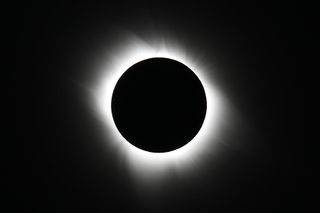
It is not too early to begin preparing for the Great American Solar Eclipse of Aug. 21, 2017 — and the sun's position on April 19, 20 and 21, but especially April 20, will offer a perfect dress rehearsal for that historic event.
When preparing for the eclipse, an important aspect to consider is the sun's location in the sky for your location. Across the western third of the United States, the eclipse will reach its peak during the late morning hours. Over the nation's midsection, the maximum eclipse will come at midday, and for the eastern third of the country, the time of greatest coverage of the sun by the moon will happen in early to mid-afternoon.
Will tall trees or nearby buildings block your view of the sun at the critical moment? You can get a very good idea of where the sun will be in the sky during the eclipse by noting its position on April 19, 20 and 21. [Total Solar Eclipse 2017: When, Where and How to See It (Safely)]
During these three days, the sun will track across the sky along a path that will be very similar to the path it will take on the actual eclipse day, Aug. 21. In fact, the path that the sun will take on Friday, April 21 will virtually match its track on the day of the eclipse. The declination of the sun — its angular distance north of the celestial equator — will be equal to 11.73degreeson April 20, compared to 11.87degreeson Aug. 21, a difference of just 0.14 of a degree.
On April 20, the sun will be less than a half degree (equal to its apparent width) to the south of its path on eclipse day, while on April 21, it will be a similar distance to the north of its Aug. 21 position.
The only other significant difference is that the sun will arrive at its eclipse-day position about 4 minutes earlier on the three April dates compared to Aug. 21. The reason for this difference is related to what is known as the "equation of time," which is a way of quantifying the variable part of the difference between time kept by an ordinary electrical or mechanical clock and the time kept by the sun, such as what a sundial would read.
Put in simple terms, in late April, the sun appears to cross the meridian about 4 minutes earlier than it does in late August.
Get the Space.com Newsletter
Breaking space news, the latest updates on rocket launches, skywatching events and more!
Below, you'll find a table for 20 selected cities. In the first column is the location. In the second column is the local time for the peak of the eclipse on Aug. 21. In the third column is the obscuration value — the maximum total area of the sun's disk that will be covered — expressed as a percentage for the places where observers will witness a partial eclipse. For a total eclipse, a value of 100 percent (in bold type) is assigned.
| San Francisco | 10:15 a.m. | 76% |
| Salem, Oregon | 10:17 a.m. | 100% |
| Seattle | 10:20 a.m. | 92% |
| Los Angeles | 10:21 a.m. | 62% |
| Tucson, Arizona | 10:36 a.m. | 59% |
| Casper, Wyoming | 11:43 a.m. | 100% |
| Denver | 11:47 a.m. | 92% |
| Lincoln, Nebraska | 1:02 p.m. | 100% |
| Austin, Texas | 1:10 p.m. | 65% |
| Columbia, Missouri | 1:12 p.m. | 100% |
| Chicago | 1:19 p.m. | 87% |
| Nashville, Tennessee | 1:27 p.m. | 100% |
| New Orleans | 1:29 p.m. | 75% |
| Atlanta | 2:36 p.m. | 97% |
| Montreal | 2:38 p.m. | 58% |
| Washington, D.C. | 2:42 p.m. | 81% |
| New York | 2:44 p.m. | 72% |
| Charleston, South Carolina | 2:46 p.m. | 100% |
Now, if you want to get a good idea of where the sun will be in the sky on Aug. 21 at the time of maximum eclipse, consult the table and subtract 4 minutes from the time provided in column 2. On April 19, 20 and 21, step outside at that moment and look skyward; that is where the sun will be on Aug. 21 at the peak of the eclipse. (Do not look directly at the sun without appropriate eye protection.)
For example, from Charleston, South Carolina, on April 20 at 2:42 p.m., the sun will be at the very same position in the sky as it will be on Aug. 21 at 2:46 p.m., when it will be in total eclipse.
Joe Rao serves as an instructor and guest lecturer at New York's Hayden Planetarium. He writes about astronomy for Natural History magazine, the Farmer's Almanac and other publications, and he is also an on-camera meteorologist for Verizon Fios1 News, based in Rye Brook, New York. Follow us @Spacedotcom, Facebook and Google+. Original article on Space.com.
Join our Space Forums to keep talking space on the latest missions, night sky and more! And if you have a news tip, correction or comment, let us know at: community@space.com.

Joe Rao is Space.com's skywatching columnist, as well as a veteran meteorologist and eclipse chaser who also serves as an instructor and guest lecturer at New York's Hayden Planetarium. He writes about astronomy for Natural History magazine, the Farmers' Almanac and other publications. Joe is an 8-time Emmy-nominated meteorologist who served the Putnam Valley region of New York for over 21 years. You can find him on Twitter and YouTube tracking lunar and solar eclipses, meteor showers and more. To find out Joe's latest project, visit him on Twitter.
